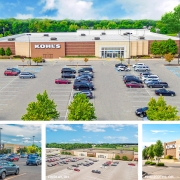1031 exchange real estate can present great opportunities for investors who want to move seamlessly from one property to another, while obtaining tax benefits on sale proceeds that provide them with more capital to put into a new property.
However, in order to get all the tax benefits of a 1031 exchange, a deal must meet specific parameters and a specific set of rules and timelines must be met throughout the entire process and the necessary transactions.
You can consider this guide the CliffsNotes for 1031 exchanges or a 1031 exchange for Dummies handbook, which will provide an overview of 1031 exchanges and explain all the rules, eligibilities, and timeframes that you need to know if you’re considering changing or upgrading the properties in your investment portfolio.
What is a 1031 Exchange?
A 1031 exchange is the commercial real estate investment term derived from the Internal Revenue Code (IRC), section 1031, which states, “No gain or loss shall be recognized on the exchange of real property held for productive use in a trade or business or for investment if such real property is exchanged solely for real property of like kind which is to be held either for productive use in a trade or business or for investment.”
Essentially, 1031 exchange properties allows an investor to sell a property and then use tax-free profits from that sale toward the purchase of another investment property that is of similar value (or greater).
A 1031 exchange can be extremely advantageous for investors who are looking to diversify their portfolio with a more profitable property type or move into a different, more passive type of investment.
For example, at Sands Investment Group, we’re seeing a shift in investment strategy that leverages the 1031 exchange. Many of our buyers are investors who are looking to sell an existing, high-touch investment property (such as an apartment complex) and use the tax free proceeds of a 1031 exchange to invest in a triple net (NNN) lease property that provides conservative, consistent returns, but doesn’t require landlord duties or heavy owner involvement. NNN lease properties offer a more passive income stream, and we’re seeing more and more investors opt for this route via the 1031 tax deferred exchange deal.
1031 Exchange Guidelines
A 1031 exchange can be an ideal solution for an investor who wants to move quickly out of one investment property and into another, without having to worry about taxed capital gains or paying income taxes on the sale of an existing investment property.
Along with the tax deferral opportunity inherent in the 1031 exchange comes a set of very specific rules, regulations, and timelines that must be adhered to in order to qualify for this type of deal and reap the full benefits.
We’ll now discuss those important 1031 exchange rules, timelines, and other factors influencing this type of investment.
Like Kind Exchange Properties
In order to pursue a 1031 exchange, both the existing property being sold and the new one being purchased in the deal must meet like-kind property requirements. The like-kind rule doesn’t necessarily apply to the quality of the properties, but dictates that properties exchanged must be similar in value and type and fall into the classification of “real property.”
The two properties must also be used for investment or income purposes, and cannot be for personal use. To achieve full 1031 exchange benefits, it’s also best if the property being purchased is of equal or greater value of the property being sold.
The price difference between properties in a 1031 exchange is known as a “cash boot.” If the new property being purchased in the exchange is less than the existing property that was sold, the price difference is taxable. So it’s advantageous for investors to find a replacement property as close in value to their existing one as possible, to fully take advantage of the 1031 tax exchange benefits.
Like-kind property types apply only to “real property” including land, commercial buildings, residential buildings, but no other types of assets can be used in the exchange. For example, an investor can exchange a piece of commercial land for a vacant lot, or they can sell an apartment complex for a tenant-occupied business property. However, a piece of land or an investment property cannot be exchanged for stocks or other non-property type assets in an exchange.
Transaction Expenses: What’s Covered by 1031 Exchange Funds (and What’s Not?)
Some expenses related to a 1031 exchange transaction can be covered with funds in the deal, but there are other expenses that aren’t included.
Costs that can be covered by 1031 exchange funds:
- Broker commission
- Legal and tax advisor fees associated to the deal
- Filing fees
- Title insurance
- Finder fees
- Escrow fees
Costs not covered by 1031 exchange funds:
- Insurance premiums
- Property taxes
- Repairs or maintenance
1031 Exchange Timeline
A very strict and specific set of 1031 exchange time limits and deadlines must be adhered to over the course of any 1031 exchange deal.
Here’s a basic timeline of how a 1031 exchange timeline unfolds.
- The investor sells their existing property.
- The funds from that sale are transferred to a qualified intermediary to hold in escrow for the next sale.
- Upon the sale of their existing property, the investor has 45 days from the sale date to identify the new property they want to buy in the exchange, and make an offer.
- The intermediary will transfer funds for the purchase of the new property upon accepted offer.
- The 1031 exchange deal must be finalized and close within 180 days of the sale date of the first property.
Timeline Specifics for Identifying a New Property in a 1031 Exchange
As noted above in our timeline of a 1031 exchange, an investor has 45 days (from the sale date of their existing property) to identify the property they would like to purchase in the exchange. There are a few different distinctions on identifying properties that are important to know when scoping out new investment properties.
An investor needs to look for a replacement property according to these guidelines:
- Three-Property Rule: The three-property rule allows an investor to identify up to 3 properties that they’ll potentially purchase in the 1031 exchange. The market value of the 3 properties isn’t held to any restrictions in this rule.
- 200% Rule: The 200% rule says that an investor can choose as many potential replacement properties as they like, so long as the cumulative value does not go over 200% of the existing property being sold.
- 95% Rule: The 95% rule states that an investor can identify as many potential properties as they want, as long as they can be acquired at 95% valuation or more.
Qualified 1031 Exchange Intermediaries
A key component of a 1031 exchange is working with a qualified, reputable intermediary. As outlined in the timeline above, the intermediary will play an integral role in moving and holding funds securely so that capital can be moved from the sale of one property into the investment of another without any tax implications.
In the sale of a property, proceeds from that sale remain taxable unless they’re passed through an intermediary. The funds cannot be disbursed directly to the seller and be eligible for the tax breaks outlined in a 1031 exchange.
An effective 1031 exchange intermediary oversees all the transactions involved in a 1031 exchange. They need to be able to hold funds in escrow for the sale of first property, and keep them there until it’s time to send funds over for the purchase of the replacement property. The intermediary needs to be a partial third-party, and should not have any formal relationship with anyone involved in the transaction other than facilitation.
What is a Reverse 1031 Exchange?
You may be wondering, “What if I want to purchase a new property before selling my existing investment property? Is the 1031 exchange still a viable option?”
The answer is yes, you can with a Reverse 1031 exchange. However, like with a traditional 1031 exchange, there are some rules you need to consider.
In a Reverse 1031 exchange, an investor can purchase a new property first, but that property must be held by a qualified intermediary until the other property sells. The existing property must be sold within 45 days of the purchase date of the new property, and the deal must be finalized and closed within 180 days of the purchase date.
1031 Exchange Companies
A 1031 exchange can be an advantageous way to transition into a new investment strategy or diversify your portfolio while also benefiting from the tax deferral that helps move more of the sale proceeds into the new property purchase. But the process is intricate and driven by very strict rules that must be met in order to benefit from the tax cut in a 1031 exchange. It’s not a process you want to go into alone or unprepared.
As such, it’s best to approach the 1031 exchange process with the help of skilled professionals who understand the market, know exactly how to move 1031 exchange transactions along smoothly, and can act as trusted advisors during the whole process.
Sands Investment Group has extensive 1031 exchange experience, and can help you navigate all the rules to ensure you make the best choices and obtain the full benefits of the deal. Our client-focused approach, extensive connections, and marketing expertise are just a few of the ways we’re leading the industry. In fact, we’re the fastest growing net lease investment company in America, with over 1,900 transactions in 48 states (to the tune of $4.5 Billion) since 2010.
Want to learn more? Get in touch with an expert today by calling 844.4.SIG.NNN or sending us an email at info@SIGnnn.com.











